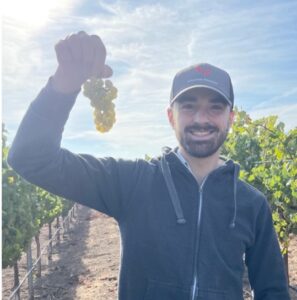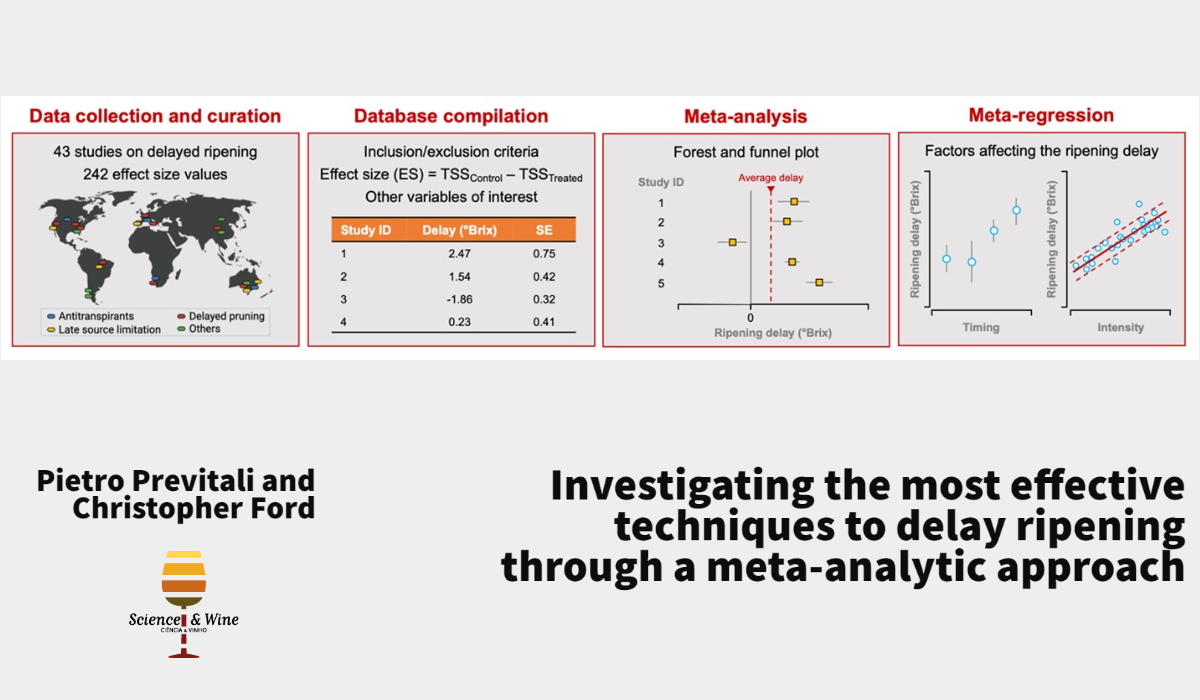By Pietro Previtali and Christopher Ford, ARC Training Centre for Innovative Wine Production and The University of Adelaide, Adelaide, Australia
When subjected to climate-change-associated phenomena including high CO2 concentrations, elevated temperature and water stress, grapes display increased rates of sugar accumulation, leading to early and more compressed harvests in several winegrowing regions. Higher potential alcohol content in wines will result from grapes containing more sugar, which clashes with the rising demand for moderate alcohol wine. Although advanced techniques for alcohol reductions are available to solve this issue, they are not enough to tackle another negative consequence of climate change, the decoupling between sugars and specialized grape metabolites.1, 2, 3 The latter are colour-, mouthfeel- and aroma-related chemical compounds that define the unique palatability of a wine. Importantly, their responses to environmental changes differ from those of sugar accumulation. While the latter quickly accelerates under the conditions described above, colour and aroma compounds have been shown to be less responsive to the same conditions and are often negatively affected. This means that colour, mouthfeel and aroma compounds are more frequently not fully developed at the desired TSS levels for harvest, pushing growers to either compromise on low flavour or high sugars.
Driven by increasing evidence that delayed sugar accumulation is beneficial for grape colour and aroma compounds, several research groups have started to investigate cost-effective techniques to delay sugar accumulation.4, 5 Individual studies conducted over the past two decades have reported inconsistent results as to the efficiency of such practices, likely due to the myriad of unique environmental and growing conditions under which the experimental trials took place. Our approach consisted of a systematic review of the available trials followed by a meta-analysis of their results. Meta-analysis uses powerful statistical techniques to analyse results pooled from studies with the same question. Based on a larger sample size and a broader range of conditions of testing, the results of meta-analysis are quantitative rather than qualitative, leading to data-driven, more accurate interpretations and statistical inference of treatment efficacy and stability.
After an extensive search and verification of studies, we compiled a database from 43 primary sources and calculated effect size (ES) values, a measure of the treatment effect on ripening. In total, 242 ES values were deemed eligible for meta-analysis. Positive and negative ES values represented a ripening delay (control > treatment) and advancement (control < treatment) respectively, and null ES (control = treatment) indicated no treatment effect (Figure 1). This quantitative variable was used to model not only the presence or absence of the effect, but also its intensity and direction. Linear mixed models were utilised to investigate factors affecting the efficacy of the three vineyard practices with the largest number of observations and ease of implementation at the commercial scale: antitranspirants (n = 102), delayed pruning (n = 45) and late source limitation (n = 56).

Figure 1. Schematic representation of the calculation of the effect size (ES) variable, representing the direction (ripening advancement vs delay) and intensity of the treatment effect based on TSS data for control and treated groups on the harvest date.
The full steps of data collection and curation, exploratory analysis, meta-analysis and meta-regression are reported in Previtali et al. (2022)6, whereas here only the most significant results are described. Statistical methods of meta-analysis confirmed the efficacy of the three treatments investigated to delay ripening. Predicted ES values by treatment were significantly different from zero and were 0.74 °Brix (antitranspirants), 1.5 °Brix (delayed pruning) and 1.2 °Brix (late source limitation). Relationships between ES values and environmental or growing factors under the control of growers were uncovered with linear mixed models that accounted for the random effects expected in trials spanning a wide range of sites, vintages and management decisions. Significant factors from these models are reported below for each treatment alongside their implications for growers’ decisions.
Antitranspirants
It has been proposed that chemical compounds with antitranspirant properties can be sprayed on grapevines in order to reduce canopy transpiration, a key driver of photosynthesis, consequently limiting sugars available for translocation to the fruit. Additionally, antitranspirants may slow down sugar accumulation indirectly, by limiting the rate of berry dehydration. Our analysis established links between ES values for antitranspirants and important factors as reported in Table 1.
Table 1. Significant factors affecting the ability of antitranspirants to delay ripening

Notes: *The chemical name is di-1-p-menthene
Delayed pruning
Delayed (or late) pruning consists of postponing vineyard pruning operations, typically executed during winter dormancy, until after budburst. Due to vine acrotony, the development of apical buds delays basal ones destined to production, which implies a potential delay in grape ripening. Meta-regression highlighted that the timing of pruning and vineyard yield, are the most important factors determining the effectiveness of late pruning to delay ripening (Table 2).
Table 2. Significant factors affecting the ability of delayed pruning to delay ripening.

Late source limitation techniques
Techniques of source limitation aim to decrease the amount of photosynthetic capacity of grapevine, also referred to as the “source” of photosynthates. During ripening, young apical leaves display the highest rate of carbon assimilation, therefore supporting the accumulation of sugars in the berry. Late apical-to-the-cluster defoliation and late shoot trimming are two candidate strategies to delay ripening by limiting the source strength of a vine. Our meta-analysis highlighted two main factors impacting the effectiveness of late source limitation, namely the TSS level set for harvest and yield conditions of the vineyard treated (Table 3).
Table 3. Significant factors affecting the ability of late source limitation techniques (i.e. late apical-to-the-cluster defoliation, late shoot trimming) to delay ripening.

Our study represents the first extensive meta-analysis in the field of viticulture and showed the power of applying rigorous statistical techniques to primary studies to address the question of whether a treatment effect is stable across environments and growing conditions. In addition, it is the first meta-analysis where treatment effects have been translated into a numerical variable (ES), allowing to pinpoint factors that can impact the effectiveness of vineyard techniques to delay ripening. The findings of this meta-analysis shed some light on aspects for growers to consider when aiming to delay ripening, such as the choice of antitranspirant compounds, the timing and intensity of application and whether the yield targets are too high or low for certain treatments to be effective.
Acknowledgements
We thank all the co-authors on this publication for their contribution: Filippo Giorgini (University of Milan Bicocca, Italy), Randall Mullen and Nick Dokoozlian (E. & J. Gallo Winery, US) and Kerry Wilkinson (University of Adelaide). This work was supported by the Australian Research Council Training Centre for Innovative Wine Production, funded by the Australian Government with additional support of Wine Australia and E. & J. Gallo Winery.

Pietro has a PhD in Wine Science at the University of Adelaide within the Australian Research Council Training Centre for Innovative Wine Production. His work has sought to understand the relationship between sugars and flavour compounds in grapes during ripening, to improve fruit composition under climate change. His PhD was conducted in collaboration with E. & J. Gallo Winery in California. After his PhD, Pietro has joined E. & J. Gallo Winery in his current role of Postdoctoral Scientist in viticulture. His research focuses on irrigation management and other vineyard practices to improve water use efficiency of grapevines.

Chris has a DPhil. in microbial biochemistry from the University of Sussex (UK). He has worked in the University of Adelaide for over 30 years and is currently an Associate Professor within the School of Agriculture, Food and Wine. He has been conducting research into grapes and wine since 1995 and has had a strong focus on improving the understanding of organic acid metabolism in plants. His work has aimed to unravel the mechanisms by which developing grape berries metabolise ascorbic, tartaric and malic acids. In recent years this extended to include investigations, with Pietro Previtali and colleagues at the University of Adelaide and E. & J. Gallo Winery, into the sugar-flavour nexus.
References
- Sadras V & Moran MA (2012). Elevated temperature decouples anthocyanins and sugars in berries of Shiraz and Cabernet Franc. Aust. J. Grape Wine Res. 18, 115–22.
- Previtali P, Dokoozlian NK, Pan BS, Wilkinson KL & Ford CM (2021). Crop load and plant water status influence the ripening rate and aroma development in berries of grapevine (Vitis vinifera L.) cv. Cabernet Sauvignon. J. Agric. Food Chem. 69, 7709–24.
- Sweetman C, Sadras V, Hancock RD, Soole KL & Ford CM (2014). Metabolic effects of elevated temperature on organic acid degradation in ripening Vitis vinifera fruit. J. Exp. Bot. 65, 5975–88.
- Gutiérrez-Gamboa G, Zheng W & Martínez de Toda F (2021). Current viticultural techniques to mitigate the effects of global warming on grape and wine quality: A comprehensive review. Food Res. Int. 139.
- Palliotti A et al (2014). Changes in vineyard establishment and canopy management urged by earlier climate-related grape ripening: A review. Sci. Hortic. (Amsterdam). 178, 43–54.
- Previtali P et al (2022). A systematic review and meta-analysis of vineyard techniques used to delay ripening. Hortic. Res. uhac118

